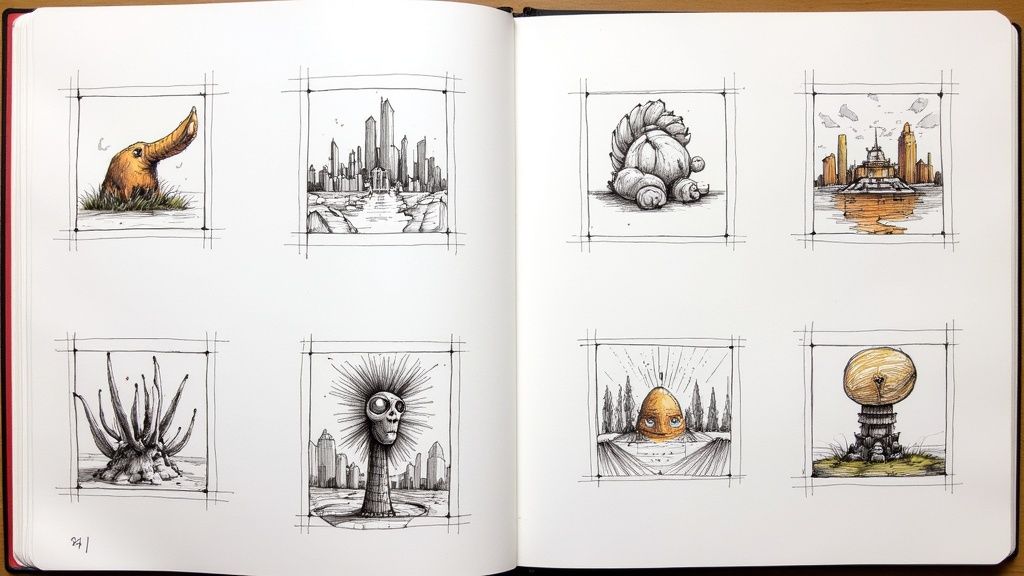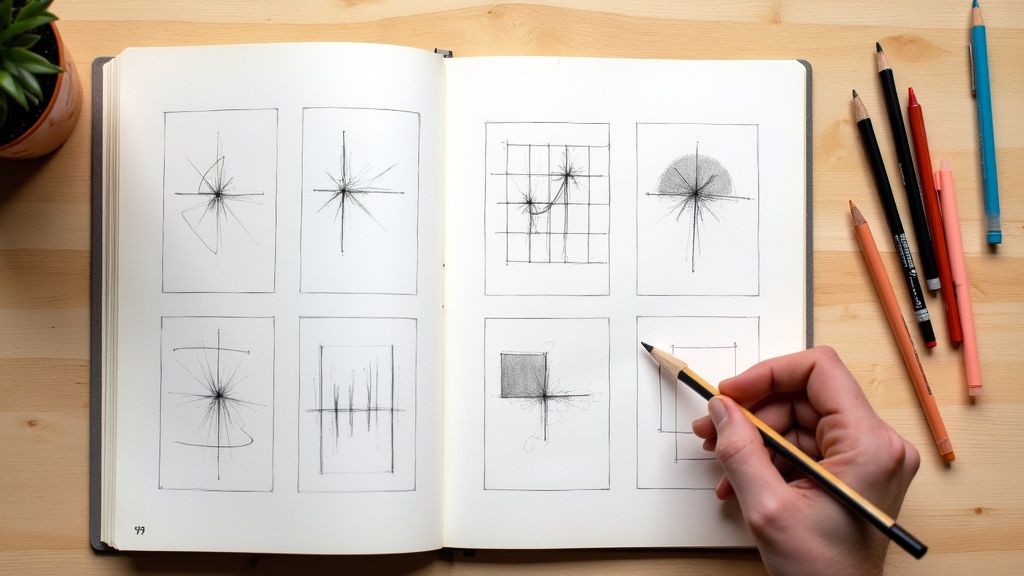Getting Started
Every artist, from the seasoned professional to the dedicated hobbyist, encounters the dreaded blank page. This universal challenge isn't a sign of failure but a common hurdle in the creative process. The most effective way to overcome this block and ignite your imagination is with a well-defined starting point. That's where this comprehensive list of art prompt ideas comes in. Forget vague suggestions; this collection is designed to provide concrete, actionable starting points that push your technical skills and narrative abilities in new directions. We have curated a diverse range of prompts that move beyond simple objects and delve into complex themes, emotions, and technical challenges.
This article provides a structured toolkit of unique and engaging art prompt ideas, organized to help you find the perfect inspiration for your next piece. Whether you need a quick daily warm-up or a deep, multi-day project, you'll find a concept here to get you drawing. We will explore everything from Character Design Challenges and Environmental Storytelling Prompts to more abstract concepts like Emotion-Based and Sensory Experience Prompts. Each category is crafted to spark fresh perspectives and encourage you to experiment with new styles, subjects, and compositions, transforming that intimidating blank canvas into an opportunity for growth.
1. Daily Art Challenge Prompts
Daily art challenges are structured, themed events designed to foster consistent creative practice over a set period, typically ranging from a week to a full year. These challenges provide a single, focused art prompt idea for each day, removing the pressure of deciding what to create. This approach is excellent for building a creative habit, rapidly improving a specific skill, and developing a substantial body of work in a short time. Famous examples like Inktober, created by Jake Parker, challenge artists to produce an ink drawing daily for 31 days, while others like MerMay focus on a specific subject.
The power of these challenges lies in their structure and community. By committing to a daily prompt, you systematically explore new themes and techniques, pushing beyond your comfort zone. This method is particularly effective for artists experiencing a creative block or those looking to build discipline and momentum.
Key Aspects of Daily Challenges
To help you get started, the following infographic summarizes the core components that make daily art challenges such a powerful tool for creative growth.

As the visualization highlights, the combination of a defined duration, scalable difficulty, and community interaction creates a highly supportive environment for artistic development. For best results, choose a challenge that aligns with your current skill level and creative goals. If you're new to daily drawing, consider starting with a 7-day or 30-day challenge rather than committing to a 100-day project. Remember to use the associated hashtags on social media to connect with other participants, share your progress, and gain valuable accountability.
2. Emotion-Based Art Prompts
Emotion-based art prompts challenge you to translate abstract feelings, moods, and psychological states into tangible visual forms. Instead of focusing on a physical subject, this approach encourages an introspective journey, using color, composition, and symbolism to convey a specific emotional experience. Artists like Frida Kahlo and Wassily Kandinsky pioneered this method, demonstrating how art can serve as a powerful medium for emotional self-expression and exploration.
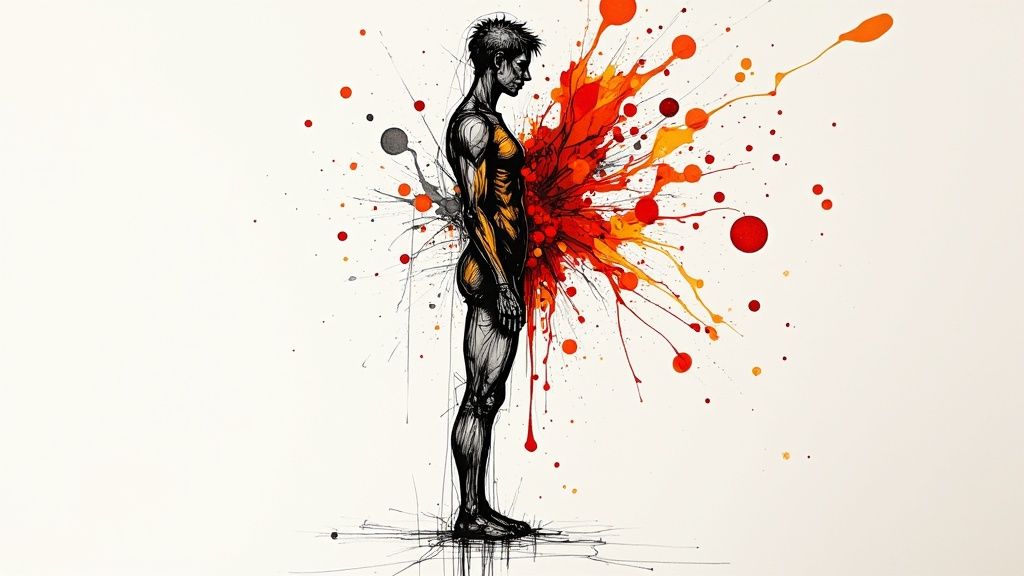
The strength of these art prompt ideas lies in their ability to foster a deeper connection between the artist and their work. Prompts such as "illustrate the weight of responsibility" or "paint the color of homesickness" push you beyond simple representation. This method is ideal for artists seeking to develop a more personal style or to work through complex feelings in a constructive, therapeutic way. It transforms the creative process into a form of visual journaling.
How to Approach Emotional Prompts
To effectively translate feeling into art, focus on sensory and symbolic representation. This method is less about technical perfection and more about authentic expression.
- Create a Safe Space: Ensure your creative environment feels secure and private. This allows for honest exploration without fear of judgment.
- Use Music and Scents: Enhance your connection to a specific emotion by playing music or using scents that evoke that feeling for you.
- Experiment with Mediums: Different materials can convey different feelings. Try using sharp, aggressive lines with charcoal for anger, or soft, blended watercolors for sadness.
- Journal Before and After: Write down your thoughts and feelings before you start creating and reflect on the process afterward. This can clarify your intentions and reveal new insights.
These techniques help bridge the gap between an internal state and an external visual. For those interested in a more structured approach, you can explore various techniques in our guide to abstract emotion studies. By using these prompts, you not only generate unique artwork but also gain a greater understanding of your own emotional landscape.
3. Character Design Challenges
Character design challenges provide art prompt ideas focused on creating original characters, often bound by specific traits, backgrounds, or design constraints. These prompts are exceptionally useful for developing storytelling skills through visual design, as a compelling character is more than just an aesthetic creation; they are a visual narrative. This approach pushes artists to think about personality, history, and motivation, translating abstract concepts into tangible visual elements like posture, clothing, and expression. Challenges might include designing a time-traveling librarian or creating a villain who genuinely believes they are the hero.
The power of character design prompts lies in their ability to hone both technical drawing skills and narrative world-building. By working within constraints, such as illustrating a character from their silhouette alone or redesigning the same character in five different art styles, you learn to solve visual problems creatively. This method is particularly effective for artists looking to build portfolios for animation, comics, or game design, as it directly mirrors the concept development process used by studios like Disney, Blizzard Entertainment, and Studio Ghibli.
Key Aspects of Character Design Challenges
To help you create memorable and effective characters, the following infographic summarizes core principles that are central to successful character design.
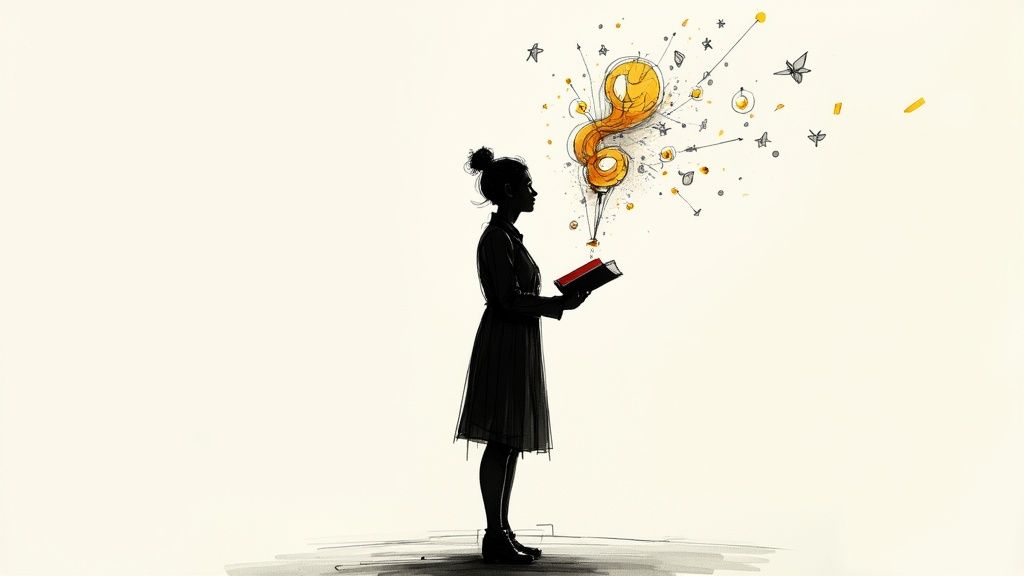
As the visualization highlights, focusing on silhouette, shape language, and color is crucial for conveying personality at a glance. For best results, begin with a character's core personality and story before sketching their physical appearance. Use reference sheets to maintain consistency, and consider how their profession and environment would influence their design. Exploring multiple thumbnail sketches first allows you to iterate quickly and avoid settling on stereotypical choices. For more specific prompts, you can learn more about character design challenges on Drawinglist.com.
4. Art Style Fusion Prompts
Art style fusion prompts challenge you to combine two or more distinct artistic movements, historical periods, or cultural aesthetics into a single, cohesive piece. These art prompt ideas encourage deep research and experimentation, pushing you to deconstruct the core principles of different styles and find innovative ways to blend them. For example, you might merge the delicate lines of Japanese ukiyo-e with the organic, flowing forms of Art Nouveau, or combine the gritty energy of street art with the meticulous techniques of Renaissance masters.
The power of this approach is its ability to generate truly unique and unexpected outcomes. By synthesizing seemingly disparate visual languages, you can create work that feels both familiar and refreshingly new. This method is ideal for artists looking to develop a signature style, break out of a creative rut, or explore art history in a hands-on, dynamic way. Artists like Kehinde Wiley, who masterfully blends classical European portraiture with contemporary Black subjects, exemplify the profound impact of style fusion.
Key Aspects of Art Style Fusion
To successfully blend different aesthetics, it's crucial to understand the fundamental elements of each style you choose to work with. The following tips can guide your creative process.
- Research Thoroughly: Begin by studying the history, key artists, and defining characteristics of each style. Understand their philosophy and context.
- Identify Key Visuals: Isolate the most recognizable elements of each style, such as the color palette, line quality, composition rules, or subject matter.
- Start with Test Pieces: Create small studies or sketches to experiment with different combinations. This allows you to explore how elements like a dynamic leap or a stoic pose translate between styles before committing to a larger piece.
- Focus on Harmony: The goal is a harmonious integration, not a clunky collage. Look for common ground or interesting contrasts that can be used to unify the artwork.
- Respect Cultural Contexts: When working with styles from different cultures, approach the subject with sensitivity and respect, avoiding stereotypes or misrepresentation.
5. Environmental Storytelling Prompts
Environmental storytelling prompts challenge artists to convey a narrative using only the setting, props, and atmosphere. This advanced technique moves beyond character-focused art, asking you to tell a compelling story through visual clues embedded within a scene. Instead of showing an action, you illustrate its aftermath or the context surrounding it, allowing the viewer to piece together the narrative. This approach is powerful for developing skills in composition, lighting, and detail, turning a simple background into the main character of your artwork.
The strength of these art prompt ideas lies in their subtlety and depth. By focusing on the environment, you can evoke complex emotions and scenarios without a single word or character. Consider a post-apocalyptic library where nature has reclaimed the shelves, or a child’s bedroom with a half-packed suitcase under the bed. These scenes are rich with implied history and emotion, making them a fantastic exercise for world-building and narrative design. This method is used extensively by concept artists in film and video games, like those working on The Last of Us or for Studio Ghibli.
Key Aspects of Environmental Storytelling
To effectively tell a story with a scene, focus on the details that suggest a past, present, or future. The following infographic breaks down the core elements needed to craft a narrative-driven environment.
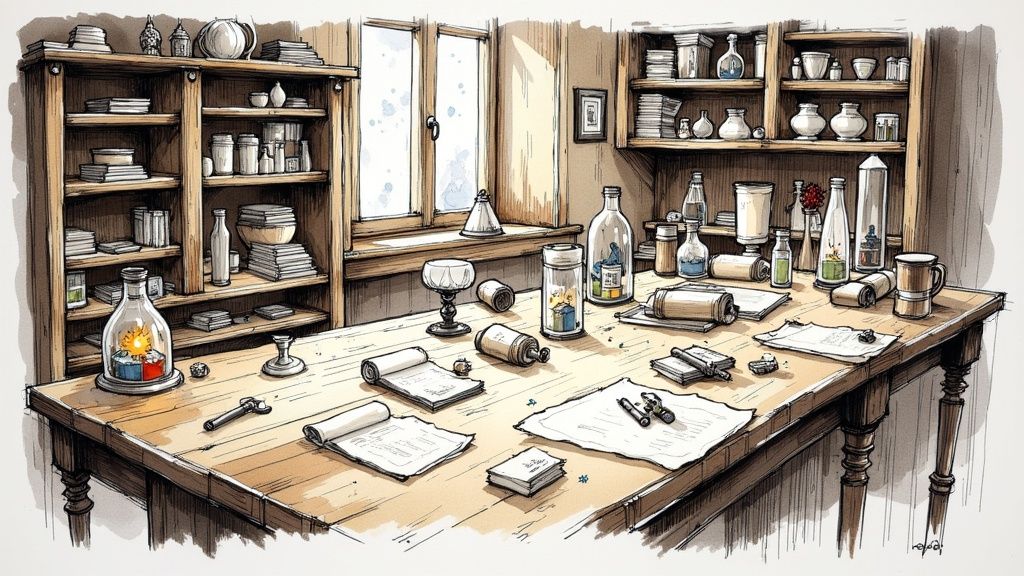
As the visualization shows, successful environmental storytelling hinges on the deliberate placement of props, the strategic use of lighting, and a strong compositional foundation. To start, try sketching several thumbnail compositions to explore different angles and focal points. When choosing objects, think about their history and what they reveal about the unseen inhabitants. For instance, an overturned teacup in a pristine kitchen suggests a sudden interruption. By mastering these elements, you can create immersive worlds that invite viewers to become detectives, discovering the story you’ve hidden in plain sight.
6. Limitation-Based Creative Prompts
Limitation-based creative prompts intentionally impose specific constraints on your artistic process to stimulate innovation and creative problem-solving. Instead of giving you a subject, these art prompt ideas give you a set of rules, such as using a limited color palette, a specific tool, or a time limit. This approach forces you to move past your usual habits and discover unconventional solutions. Artists like Piet Mondrian, known for his strict use of primary colors and geometric lines, demonstrated how powerful working within tight boundaries can be.
The strength of this method is in how it channels creativity. By removing infinite choices, you are free to focus deeply on the elements that remain. This can be especially effective for overcoming a creative block, as the constraints provide a clear starting point and a defined challenge. It encourages a playful, experimental mindset and often leads to unique and unexpected artistic outcomes that would not have emerged otherwise.
Key Aspects of Limitation-Based Prompts
To successfully leverage constraints, focus on embracing the challenge rather than fighting the rules. The following points highlight the core components that make these prompts a fantastic tool for artistic growth and fresh perspectives.
- Forced Innovation: Constraints push you out of your comfort zone. For example, creating a detailed portrait using only your non-dominant hand forces you to rethink your entire approach to line work and shading, potentially revealing a more expressive style.
- Skill Refinement: Time-based challenges, like completing a sketch in 10 minutes, are excellent for improving speed and confidence. They teach you to prioritize essential shapes and values, a key skill in fields like concept art and urban sketching.
- Creative Problem-Solving: Working with limited tools, such as using only a single large brush or found materials, turns the creative process into a puzzle. You must invent new techniques on the fly, deepening your understanding of your medium and its possibilities.
- Overcoming Perfectionism: When you have strict limitations, the goal shifts from creating a perfect masterpiece to successfully completing the challenge. This lowers the stakes and encourages a more experimental, process-oriented approach to making art.
7. Reimagined Classic Prompts
Reimagined classic prompts challenge you to take well-known artworks, fairy tales, myths, or historical events and reinterpret them through a new lens. This approach involves deconstructing a familiar narrative or image and rebuilding it in a contemporary context, a different artistic style, or an alternate reality. Examples include envisioning the Mona Lisa as a modern social media influencer or transplanting the characters of Greek mythology into a gritty, urban setting. This method offers a rich foundation of existing symbolism and narrative to build upon.
The power of this technique lies in the conversation it creates between the past and the present. By reinterpreting a classic, you can comment on societal changes, explore timeless themes in a modern light, or simply create a compelling visual juxtaposition. These art prompt ideas are perfect for artists who enjoy research and storytelling, as they blend creative interpretation with historical or cultural analysis. Artists like Kehinde Wiley, who recasts classical European portraits with contemporary Black subjects, have masterfully used this approach to challenge art historical narratives.
Key Aspects of Reimagining Classics
To effectively reinterpret a classic work, focus on creating a meaningful dialogue between the original and your new version. The goal is to add a new layer of meaning, not just copy the source material with superficial changes.
- Research the Original: Before you begin, thoroughly understand the original work’s context, symbolism, and historical significance. What was the artist's original intent? What did it mean to its contemporary audience?
- Identify Core Themes: Isolate the central themes of the piece. For Cinderella, it might be transformation and social mobility. For The Last Supper, it could be betrayal and sacrifice. Preserve these core ideas to maintain a clear link to the source.
- Inject a New Perspective: Consider what modern element, cultural shift, or alternative setting adds new meaning. For example, setting Cinderella in a cyberpunk future could be a commentary on technology and class divides.
- Make a Clear Statement: Be intentional with your changes. Every alteration, from the setting and wardrobe to the characters’ expressions, should contribute to your new artistic statement. Ask yourself: what am I trying to say with this reinterpretation?
8. Sensory Experience Prompts
Sensory experience prompts challenge artists to move beyond visual representation and interpret non-visual senses like sound, taste, smell, and touch. This method encourages you to translate a feeling or sensation into a visual medium, fostering abstract thinking and a deeper connection to your subject matter. Instead of drawing what you see, you are tasked with illustrating concepts like the sound of rain on a tin roof, the texture of a loved one's voice, or the taste of nostalgia. This approach is perfect for developing a unique visual language and breaking free from creative ruts.
The power of these art prompt ideas lies in their ability to unlock synesthetic thinking, where one sensory pathway involuntarily triggers another. Artists like Wassily Kandinsky famously visualized music, translating symphonies into dynamic compositions of color and form. By focusing on translating a feeling into marks, colors, and textures, you can create deeply personal and emotionally resonant artwork that communicates on a more intuitive level. This practice is ideal for artists looking to explore abstraction or add a new layer of symbolic meaning to their work.
Key Aspects of Sensory Prompts
To translate abstract sensations into compelling visuals, focus on the core elements of art to convey meaning. Consider how different artistic choices can represent specific sensory information.
- Color and Temperature: Use warm colors (reds, oranges) to suggest warmth, excitement, or strong flavors, while cool colors (blues, greens) can represent calmness, coldness, or subtle sounds.
- Texture and Mark-Making: Experiment with rough, jagged lines to depict a harsh sound or a coarse texture. Conversely, use smooth, flowing marks to illustrate a gentle melody or a soft surface.
- Rhythm and Pattern: Translate auditory patterns into visual rhythms. A steady beat could become a series of repeating shapes, while a chaotic noise might be represented by erratic, overlapping lines.
- Personal Memories: Draw upon your own sensory memories for authenticity. Visualizing the specific smell of a childhood home or the taste of a favorite meal provides a rich, personal foundation for your art.
9. Social Commentary Art Prompts
Social commentary art prompts challenge artists to create work that addresses current social issues, political topics, environmental concerns, or cultural phenomena. This approach transforms art from a purely aesthetic practice into a powerful medium for communication and critique. Instead of just drawing a subject, you are tasked with conveying a message, sparking a conversation, or raising awareness. Artists like Banksy and Ai Weiwei have famously used this method to engage the public on complex topics, proving that art can be a catalyst for change.
The strength of these art prompt ideas lies in their ability to foster deep, critical thinking. By tackling a prompt like "illustrate digital age isolation" or "depict wealth inequality metaphorically," you must move beyond literal representation and delve into symbolism and metaphor. This process not only hones your technical skills but also sharpens your ability to communicate nuanced ideas visually. It is an ideal approach for artists who want their work to have a meaningful impact and resonate with contemporary audiences.
Key Aspects of Social Commentary Art
To effectively translate a social issue into compelling visual art, consider the core components that give this approach its power. Successful social commentary art often balances a clear message with artistic subtlety, inviting viewers to think rather than telling them what to believe. Key strategies include using powerful symbolism, researching your topic thoroughly to ensure an informed perspective, and understanding your intended audience. For example, creating a piece on climate change by visualizing its impact on personal, everyday objects can make the abstract concept feel more immediate and relatable. Remember, the goal is to encourage reflection, not to preach, so focus on asking visual questions that prompt the viewer to seek answers.
10. Technique Mastery Prompts
Technique Mastery Prompts are exercises specifically designed to help artists practice and master a particular artistic skill, tool, or medium. Unlike thematic or narrative-driven art prompt ideas, these focus purely on the "how" of creation, isolating a single technical challenge to build muscle memory and deepen understanding. This targeted approach is invaluable for artists looking to overcome a specific weakness, whether it's drawing hands, mixing realistic skin tones, or mastering one-point perspective. It transforms practice from a general activity into a focused, goal-oriented mission.
The power of this method lies in its deliberate, repetitive nature. By concentrating on one technique, you can make significant, measurable progress in a short time. For example, committing to 30 days of two-minute gesture drawings builds an intuitive feel for movement and form far more effectively than occasionally attempting a complex, finished piece. This approach is a cornerstone of formal art education, from traditional ateliers to online platforms like Proko, because it systematically builds a strong foundational skill set.
Key Aspects of Technique Mastery
To effectively use these prompts, focus on structure and consistent application. The goal is not to create a masterpiece with each attempt but to refine a specific skill through repetition and analysis.
- Set Measurable Goals: Define what success looks like. Instead of a vague goal like "get better at color," aim for a specific target, such as "create a palette of 100 unique, harmonious colors from a limited primary set."
- Practice Consistently: Short, regular practice sessions are more effective than infrequent, long ones. A daily 15-minute perspective exercise will yield better results than a single four-hour session once a month.
- Document Your Progress: Keep a record of your work, creating before-and-after comparisons. Seeing tangible improvement over a week or month is a powerful motivator and helps identify areas that still need work.
- Combine with Creativity: Once you feel more confident, integrate the technique into a more creative piece. After a week of practicing cross-hatching textures on spheres, try applying those skills to a still life of different fruits.
Creative Prompt Types Comparison
Prompt Type | Implementation Complexity | Resource Requirements | Expected Outcomes | Ideal Use Cases | Key Advantages |
|---|---|---|---|---|---|
Daily Art Challenge Prompts | Moderate (daily commitment) | Moderate (time, community access) | Builds consistent habits and versatile portfolio | Skill development, habit building | Accountability, progressive difficulty, community engagement |
Emotion-Based Art Prompts | Low to Moderate | Low (reflective tools) | Enhances emotional intelligence and personal expression | Therapy, emotional exploration | Therapeutic benefits, improves color theory, personal connection |
Character Design Challenges | High | Moderate to High (references, time) | Develops storytelling and anatomy skills | Entertainment design, portfolio building | Storytelling, creativity, visual communication |
Art Style Fusion Prompts | High | High (research, materials) | Expands style knowledge and technical versatility | Experimental art, cross-cultural exploration | Unique style development, art history education |
Environmental Storytelling Prompts | High | Moderate to High (planning, detail) | Improves composition and narrative skills | Concept art, game/film backgrounds | Strong storytelling without characters, mood setting |
Limitation-Based Creative Prompts | Moderate | Low to Moderate (tools, time limits) | Boosts creativity and problem-solving | Skill challenges, rapid creativity exercises | Fosters resourcefulness, cohesive style |
Reimagined Classic Prompts | Moderate to High | Moderate (research, concept) | Builds critical thinking and cultural dialogue | Art history reinterpretation, conceptual art | Balances homage and innovation, cultural dialogue |
Sensory Experience Prompts | Moderate | Low (conceptual focus) | Develops abstract thinking and metaphor skills | Experimental and abstract art | Unique art, metaphorical vocabulary development |
Social Commentary Art Prompts | High | Moderate to High (research, sensitivity) | Creates meaningful, impactful art | Activism, socially engaged art | Critical thinking, civic engagement, awareness raising |
Technique Mastery Prompts | Moderate | Low to Moderate (tools, time) | Builds technical skills and measurable progress | Skill improvement, disciplined practice | Clear objectives, measurable progress, strong foundation |
Final Thoughts
We've explored a vast landscape of creative catalysts, moving far beyond generic lists to uncover truly compelling art prompt ideas that can fundamentally change how you approach your craft. From the structured discipline of daily challenges to the profound narrative depth of environmental storytelling, the core takeaway is clear: the right prompt is not just a subject to draw, but a framework for growth. It’s an invitation to solve a unique visual problem, pushing you past your comfort zone and into new territories of skill and imagination.
By engaging with these diverse categories, you do more than just fill a blank page. You are actively building a more versatile artistic toolkit. Emotion-based prompts teach you to translate abstract feelings into tangible forms, while character design challenges hone your ability to convey personality through visual cues. Each category we discussed targets a different artistic "muscle," ensuring a well-rounded development that combats creative stagnation.
Turning Inspiration into Action
The true value of these art prompt ideas is realized only through consistent practice. Reading this list is the first step, but the magic happens when you pick up your pencil, stylus, or brush and begin the work. Here’s a practical plan to integrate these concepts into your creative routine:
- Create a "Prompt Jar": Don't just wait for inspiration to strike. Physically or digitally, create a collection of your favorite prompts from this article. Mix and match from different categories like "Limitation-Based" and "Art Style Fusion" for an unexpected challenge. When you feel stuck, pull one out and commit to seeing it through.
- Schedule Your Creativity: Dedicate specific times in your week to "prompt practice." Perhaps Mondays are for "Technique Mastery," Wednesdays for "Environmental Storytelling," and Fridays are for fun "Reimagined Classics." Treating it like a scheduled workout makes it a non-negotiable part of your artistic development.
- Share and Reflect: Don't create in a vacuum. Share your work with a community, a friend, or on social media. The act of sharing often provides new perspectives, and articulating your process in a caption can clarify your own artistic intentions and learning.
Ultimately, mastering the art of the prompt is about learning to ask better questions of yourself and your art. It’s about cultivating a mindset of curiosity and intentionality. Instead of asking, "What should I draw?" you begin to ask, "What story can I tell?" or "What new technique can I explore?" This shift transforms art from a mere activity into a continuous journey of discovery, ensuring that the dreaded artist's block becomes a thing of the past. You now have the tools to build your own runway for creative takeoff, anytime you need it.
If you’re looking for a consistent, daily source of high-quality prompts to keep your creative momentum going, check out Drawing List. It provides curated, daily art prompt ideas designed to challenge and inspire artists of all levels, directly aligning with the principles we've discussed. You can find your next great idea at Drawing List.
